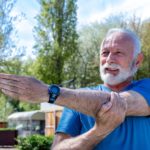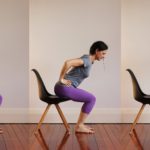
Kim Hoffmann
NASM CES (Corrective Exercise Specialist) and Certified Personal Trainer
Exercise and frequent training is not something that all of us can schedule in on a weekly basis.
This can sometimes create a risky mindset where we tend to overdo and overexert ourselves to compensate for a missed session, thinking that the higher the intensity of physical effort, the better off we are.
This is where Zone Training adds an important benefit to the efficiency of our exercises and training sessions, and it can also ensure that we stay within our limits, which lowers the risk of injuries.
What is Zone Training?
Zone training is an approach to exercising in 5 different heart rate zones, mostly doing cardiorespiratory training and exercises.
Each zone has its function and advantages for shorter or longer endurance and strength training.
Another reason for using zone training is that it helps us to condition our body which then increases our chances of reaching our goals.
Zone training helps us to condition our body
When we’re preparing to run a race, we should not run 20 kms every time we practise, which means we need to improve our time and speed in another way.
Zone training is also used to keep ourselves from overtraining.
It forces us to stay within certain zones and improve our fitness or racing time in a different way than we might be used to.
This also prevents us from becoming overconfident to do too much too soon, because such a mindset can easily lead to an injury.
History of Zone Training
In 1977, a Finnish professor, Seppo Säynäjäkangas, invented a fingertip heart rate monitor to help the Finnish National Cross Country Ski team with their training. Later on he founded a company called Polar Electro.
Säynäjäkangas said he came across the idea of a heart rate monitor while on the ski slopes, wondering how he could measure heart rates during training.
In 1978, they came out with their first retail product, a wearable heart rate monitor and 4 years later, they started selling chest belts.
Initially, people seemed reluctant to adopt this new device, even though coaches and athletes had always been interested in using pulse to measure exertion and thus performance.
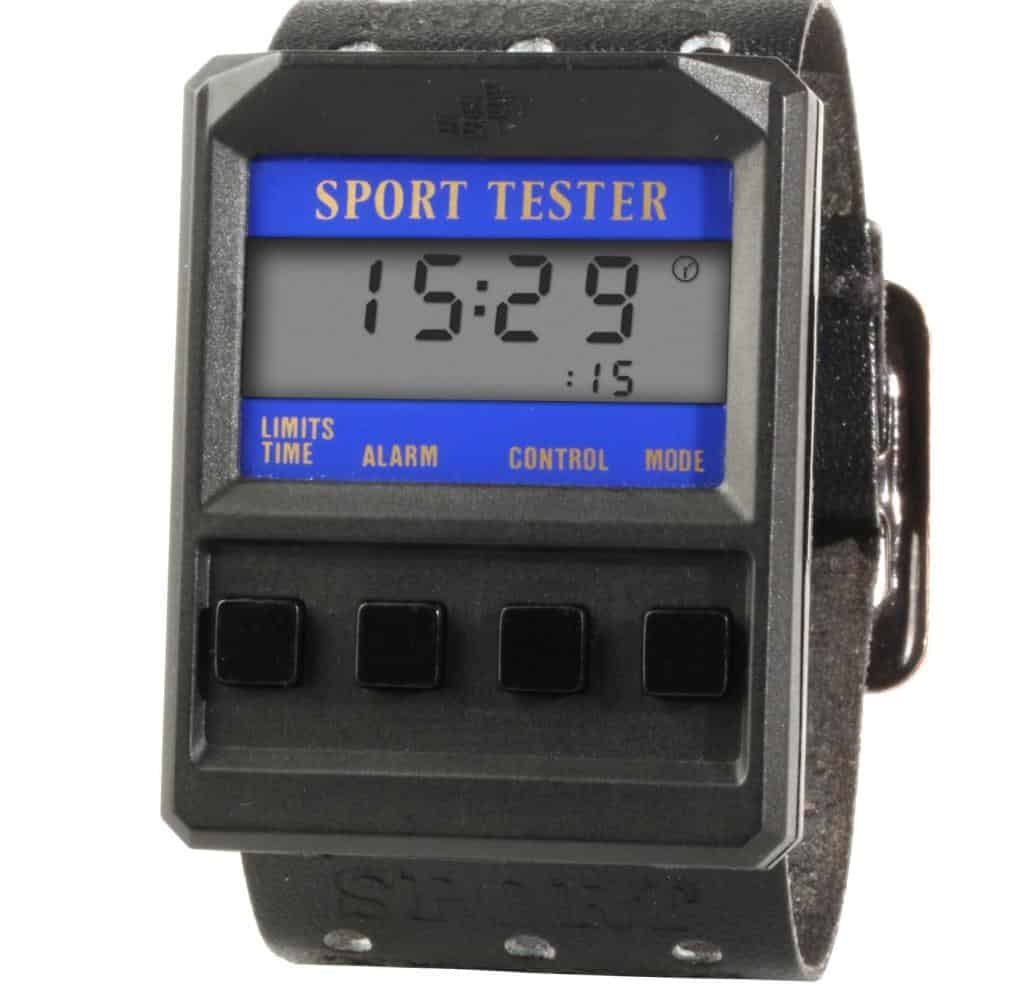
However, in 1984, there was a surprise in the cycling world, when Francesco Moser, an Italian cyclist, broke the 1-hour record set by Eddy Merckx in 1972.
While Merckx was considered the greatest cyclist of all time and Moser an average cyclist at the end of his career, Moser managed to break Merckx’s record (49.431 kms) by riding 51.151 km in one hour.
Moser’s secret? The way he trained. Until then, riders trained in groups and used perceived exertion as a measurement to improve their performance.
Moser, on the other hand, had been training with an Italian physician, Francesco Conconi who had been using Säynäjäkangas’ heart rate monitor for his own track running.
Conconi noticed that when graphing his running paces, that the exercise intensity and heart rate were actually not linear, since it was previously thought that when exercise intensity increases, so would the heart rate.
Conconi saw that the heart rate would plateau when nearing maximal exercise intensities, and he called this the anaerobic threshold, later known as the Conconi Test.
Moser began using the heart rate monitor to determine his anaerobic threshold and started training (a lot) at that specific heart rate to improve his time and performance. This is how he beat Merckx’s record.
Later on, in the 80s and 90s, various companies started coming out with wristwatches that incorporated some form of monitoring exercise, such as recording steps and calories.
This is where we had Casio JC-11 (monitoring jogging and running) in 1988 and the BP-100 (monitoring blood pressure and pulse) in 1990.
Later on Garmin and a few other companies joined the industry, the latest being Fitbit.
Different terms that we should be aware of
Since many reading the article will be just starting out with zone training, we’ve decided to share some of the most important “technical expressions” to be mindful of.
In the following article we’ll go into more detail.
Resting Heart Rate (RHR)
This is the rate our heart beats at rest, when we’re doing no activity whatsoever. It might vary from 60 beats per minute (bpm) to up to 100 bpm.
Women have a higher heart rate than men with an average of 78–82 bmp. Men are generally around 70–72 bpm.
Maximum Heart Rate (HR Max / MHR)
This is where our body is at maximum exertion, and our heart is beating its absolute fastest rate.[1]
Maximum heart depends on the age and the current physical condition, and is the most important part when setting up a personal training program.
Rate of Perceived Exertion (RPE)
The Borg Rating of Perceived Exertion (RPE) is a way of measuring physical activity intensity level.
Perceived exertion is how hard we feel like our body is working, so it’s very subjective. It’s based on an
- elevated heart rate
- muscle fatigue
- increased breathing
Recovery Heart Rate (RHR) / Heart Rate Recovery (HRR)
Our heart rate increases during vigorous exercise. After some time, it should return to normal.
The amount of time it takes for our heart rate to return to its resting rate is Recovery Heart Rate.
What are the different zones and how do they affect our training?
It’s important to know what zone we’re spending the most time in when working out or competing because this will improve performance.
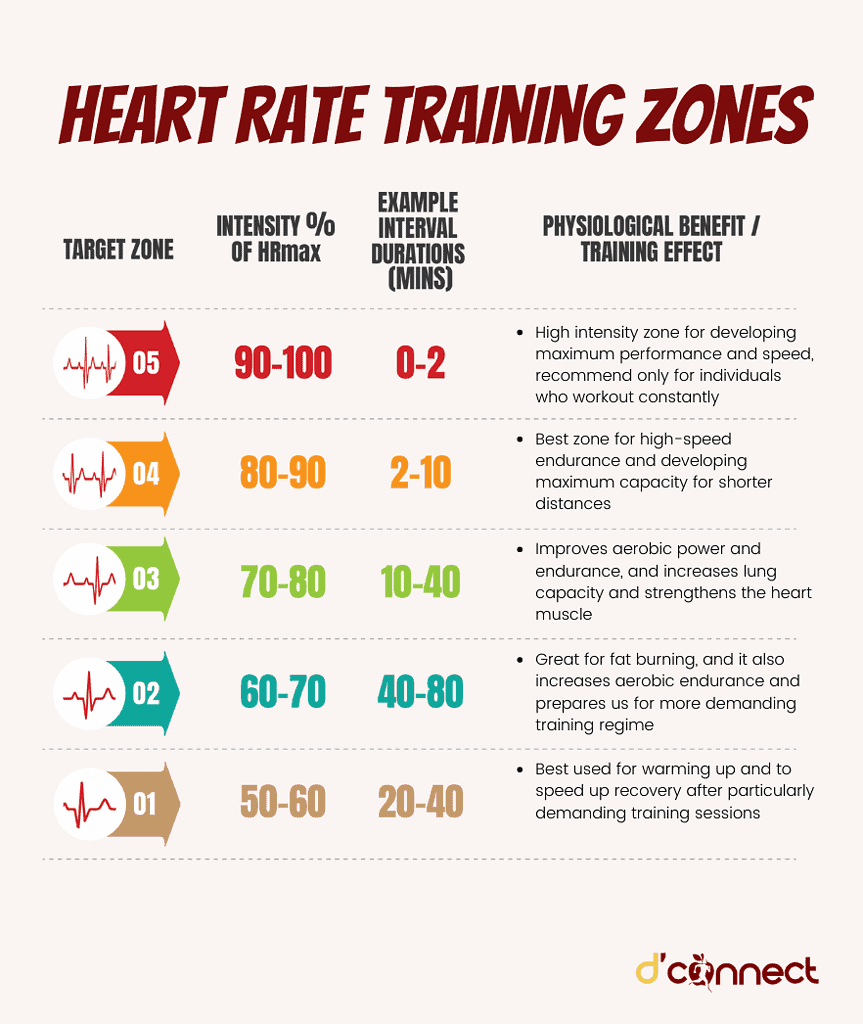
For some of us that are just starting, knowing this information can also help with burning fat or longevity. That is why we’ll explain in more detail each of the zones.
Zone 1 Training
This level is equivalent to doing everyday tasks, so we shouldn’t feel any tiredness at all.
I would suggest using Zone 1 for warming up or as recovery after a heavy session. We should be working at 50–60% of our maximum heart rate.
Zone 1 is great for warming up
If using Zone 1 for recovery, it will increase blood flow, which helps to speed up recovery and improve our cardiovascular system.
At the beginning you might feel that you are running out of air easily, but after a few weeks of training, you will notice your heart and lungs are doing a lot better. This is your aerobic heart rate zone improving.
Also, you might experience some fat loss when first starting out, because fat is the main source of fuel in Zone 1.
I would also suggest combining this workout with weight lifting in order to continue/accelerate this fat loss, if that’s your goal.
Zone 2 Training
Zone 2 should still feel easy and we should be able to hold a conversation, no matter the activity. Our heart rate should be at about 60–70% of our maximum heart rate.
Most people accidentally end up in Zone 3 and miss out on important benefits from Zone 2.
Training in Zone 2 builds mitochondria in slow-twitch muscles fibres that help with endurance and speed.
Mitochondria are also an indication of overall health. If we have healthy mitochondria, we’ll have a healthy immune system, with less chance of insulin resistance, which can cause diabetes, among other things.
RELATED — Type 1 Diabetes: Autoimmune disease that is on the rise
People often go too fast, whether it’s running, cycling or rowing, which is why they end up in zone 3 and start burning their reserves of carbohydrates, which unlike fat reserves, deplete very fast.
Also, when we burn too much energy too quickly, the body produces more lactic acid than it can handle at one given time. To extend the duration of the activity/training/race, we should decrease the intensity.
This is where relying on fat as energy will keep us going for longer.
Zone 3 Training
In this zone we should start feeling more fatigued and holding a conversation should be difficult. Our heart rate should be at about 70–80% of our max heart rate.

Source: FreePik
Typically, in Zone 3 we aren’t going fast enough to consider it hard, but we are also not going slow enough to get the benefits of a Zone 1 and 2 workout. This is why Zone 3 is also known as the “grey zone”.
Zone 3 still improves our aerobic capacities, which is good for long distance races.
As in Zone 2, this zone also builds mitochondria, but it also helps build capillaries which improve oxygen delivery throughout the body and will make using our muscles more efficient.
The majority of people make the mistake of constantly training in this zone.
Zone 3 makes the moderate intensity training more manageable
This means that we’re not gaining that power and speed we’re aiming for and it’s too intense for our body to fully recover.
Zone 4 Training
Zone 4 is more high intensity which is necessary to improve our performance or race time. In this zone we use 80–90% of our max heart rate and we take longer breaks in between sets/rounds.
The “danger” of this zone is that people often push themselves too far without giving the body time to recover.
This puts a lot of stress on the body and it undoes everything we’ve worked so hard for in zones 1–3.
Zone 4 improves our anaerobic threshold
This threshold is the point where so much lactic acid, or lactate, starts to build up, that our muscles become fatigued. So training in this zone will recondition the body to tolerate lactate levels better.[2]
Another advantage of training in Zone 4 is that it builds power in our muscles, which means we can keep the intensity of training for longer.
Zone 5 Training
This is the zone we’ll spend the least amount of time in because of its high intensity. In Zone 5 we use 90–100% of our max heart rate.
This means working on maximum level/speed for 10–20 seconds.
Massive amounts of lactic acid that are produced at this intensity make the muscles get tight very fast, forcing us to slow down or stop.
Zone 5 is beneficial as long as we don’t achieve complete exhaustion and rest enough in between the rounds as well as after each session.

Source: FreePik
This will build the mitochondria in the fast-twitch muscles, improving our endurance in the long run.[3]
This zone is also good for practising your starting and reaction time, especially if you are enjoying sports like athletics (sprints), rowing and kayaking, and even martial arts, such as boxing.
Training plan
A typical training plan utilises multiple training zones.
We shouldn’t train in each zone for an equal amount of time and nor use all of them in every training.
Specific zone training depends on our goals. However, we will spend the majority of our training in the lower heart rate zones.
If you’re completely new to exercise, you will spend a lot of time in Zones 1–3. This is because the body needs to get used to moving. Mileage is more important than being fast. Speed comes with training.
If your goal is losing weight, then you should focus on Zones 1–3 and combine that with weight training to encourage fat burning.
Cardio workouts in lower heart rate zones are good for burning calories, but muscles use energy even when at rest. So for weight loss, it’s important to increase our muscle size and use cardio in the lower heart rate zones.
Running or walking
These two activities depend on our general health and level of fitness. If we’re just starting out, or haven’t worked out for a while, the safest option would be to take longer walks.
You should be able to walk about 45–60 minutes at a comfortable pace. Include some hills later on to challenge yourself.
Once you can do that comfortably, add jogging, running, cycling or other types of activities.
Below is an example of a training plan for an individual who wants to start running for weight loss but is completely new to exercise.
| Monday | Tuesday | Wednesday / Saturday | |
| Weight training |
|
Rest | |
| Thursday | Friday | Sunday | |
| Weight training |
|
1–2 hour walk | |
Here is another example of a training plan if you’re a bit more experienced/fitter, but would like to lose some weight.
| Monday | Tuesday | Wednesday |
| 1 hr run in Zone 2 | Weight training |
|
| Thursday / Saturday | Friday | Sunday |
| Rest / Mobility work |
| 1–2 hour walk / 45–minute recovery run |
When we’re starting out, it’s important that we don’t have any injuries and are not getting injured while exercising.
If you have never exercised before or are coming back from an injury, talk to your doctor and physio about your plans and get them involved.
Summary
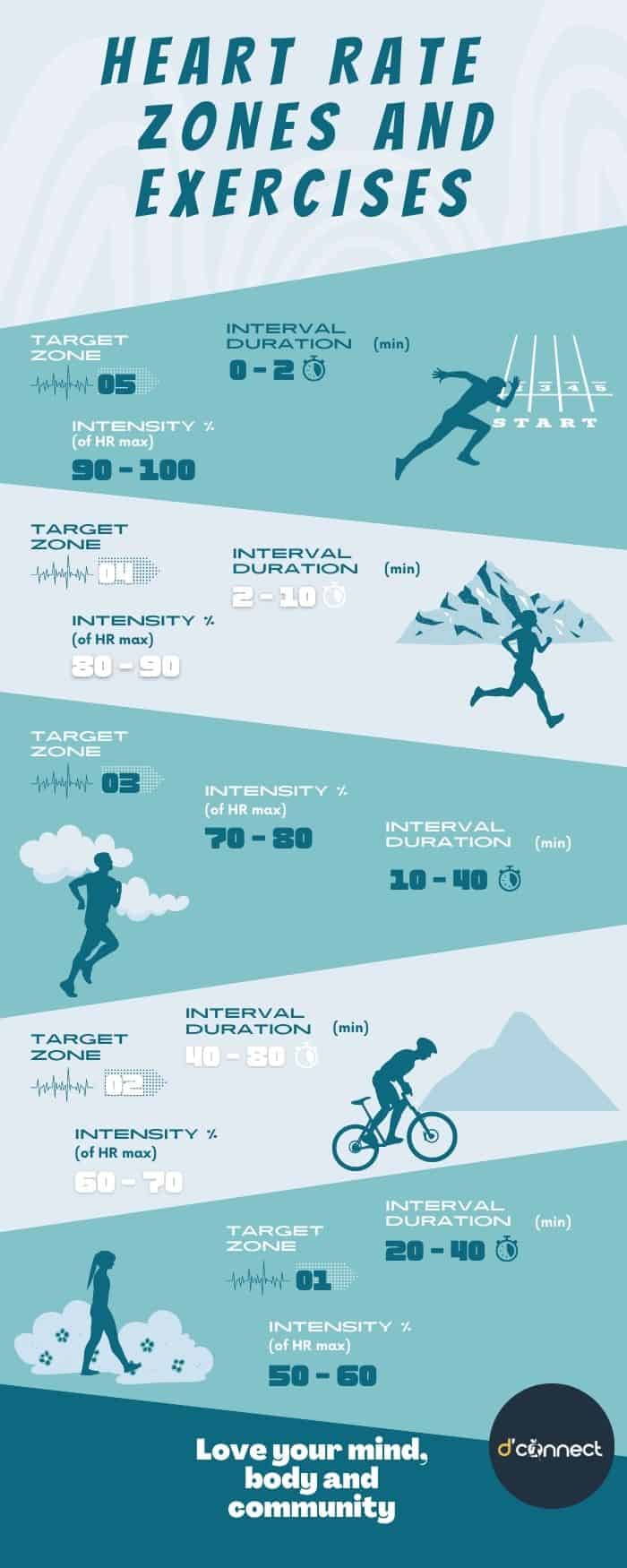
Note — feel free to download and share this illustration.
Related Questions
1. Which zone is best for weight loss?
Zone 1 and Zone 2 are ideal for weight loss and burning fat.
However, exercising in zones 3–5 will give us other benefits to complement zones 1 and 2.
2. Which zone is best for cardiovascular health and maintenance?
All heart rate zones are beneficial to the heart and lungs.
The general recommendation is 150 minutes of moderate exercise a week in Zones 1–3.
3. Are there any downsides or negatives to heart rate training?
People with high or low blood pressure or obsessive behaviours might not want to use an HRM, as this can cause problems for their physical and mental health.
Some people do better without data to support their training, or at least a different kind of data.
If you liked the article or have any questions about zone training and how to start, feel free to let us know in the comments below and we’ll endeavour to reply as soon as possible.
Kim Hoffmann is a certified Personal Trainer and Corrective Exercise Specialist based in Auckland. She also specialises in women’s health and fitness by taking into consideration the menstrual cycle and hormones and implementing them in different workout plans. The workout methods and routines include free weights, suspension straps and boxing, as well as strength training and high intensity.
Kim’s passion is helping people move better and improve their quality of life. She helps men and women of all ages achieve their goals and also offers online classes and consultations. You can see more of Kim at Snatch Fitness.
References
(1) Tanaka, H., Monahan, K.D., and Seals D.R. (2001) Age-Predicted Maximal Heart Rate Revisited. Retrieved from https://www.jacc.org/doi/epdf/10.1016/S0735-1097%2800%2901054-8
(2) Polar ANAEROBIC THRESHOLD: WHAT IS IT AND HOW CAN YOU MEASURE IT? Retrieved from https://www.polar.com/blog/understand-anaerobic-threshold/
(3) Maglischo, E.W. Training Fast Twitch Muscle Fibers: Why and How. Retrieved from https://citeseerx.ist.psu.edu/document?repid=rep1&type=pdf&doi=60cb52ee31f9b9b02f1a1e51a8974bdaa47a4128


